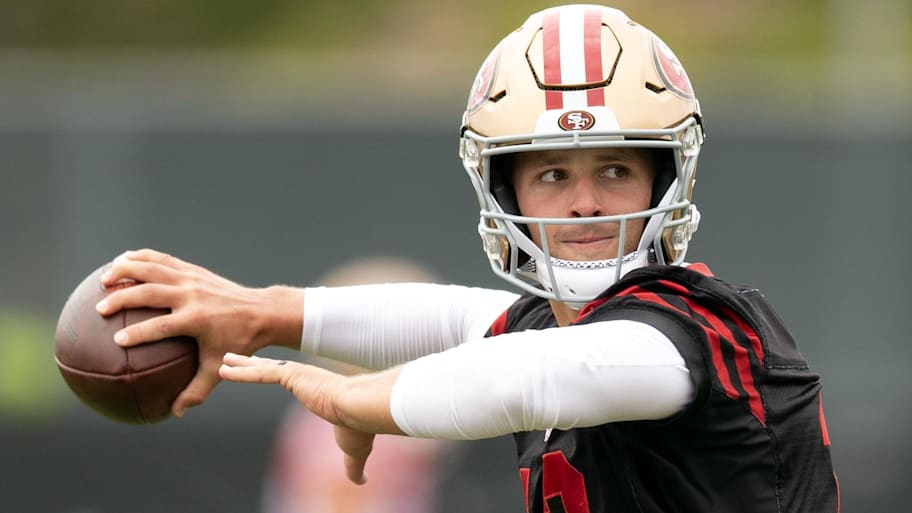We’re wrapping up our NFL training camp trip with some stuff that we built up over the past month or so, plus some news, and everything else in between. So here’s the final set of pre-September MMQB Takeaways …
49ers
The 49ers might not be good enough right now, but the plan is to be when it really counts. The reality of San Francisco’s situation going into camp was similar to the one confronted by the Rams two years ago, and the Bills last year. Specifically, the time had come to rip the salary-cap Band-Aid off, and for the team to take its financial medicine. That happened in the late winter and spring, fundamentally changing the summer roster.
What was left behind, as was the case in Los Angeles in 2023 and Buffalo in ’24, was a team assembled while threading the needle through a ton of dead-cap charges.
This obviously isn’t a new phenomenon. But there’s a subtle difference to this one by the 49ers.
Kyle Shanahan can explain.
“There are examples [of this kind of retooling] all over,” he told me in a quiet moment earlier in camp. “I look at some of those players who left their teams—How good were they at that time? Did they get really paid by other teams? Are they going to help other teams? I think we let go of some guys that can still really play, and still really do it, so that’s the difference. You always have to make a decision to let go of a guy, usually a year before everyone else can see it, because usually you can see it …”
But that’s not what this was. The Niners weren’t letting guys go who were losing it.
“That’s what was so tough for me personally as a coach, was sitting here in March and knowing it was gonna come, but still hoping we could get lucky,” he continued. “And then having to really sit there and watch someone like Dre Greenlaw leave, someone like ‘Huff’ [Talanoa Hufanga] leave, not being able to afford [Jordan] J.P. Mason. These are really good players, really good people.”
In their places are mostly younger guys. Therein, the Niners’ ability to draft and develop—proven over nearly a decade by Shanahan and GM John Lynch—will be put under the microscope once again.
The situation the team is in is probably most apparent along the defensive front, where three rookies—DE Mykel Williams and DTs Alfred Collins and CJ West—are going to have to play a lot, and play well alongside the unit’s cornerstone, Nick Bosa. Rookie linebacker Nick Martin is fighting for snaps, while promising third-year man Dee Winters takes Greenlaw’s old spot. In the secondary, rookie Upton Stout and second-year safety Malik Mustapha (when he gets back from a tough knee injury) should be prominently in the mix.
The offense is more reliant on veterans, though any injury issue at receiver or running back could press younger guys into action.
“I think you embrace it, and you’re buoyed by the fact that we have people that we respect that did it,” GM John Lynch says. “The Rams have done a nice job of doing that and never missed a beat and stayed competitive. And then Buffalo, obviously, it helps when you’ve got Josh Allen, but, hey, we’ve got Brock [Purdy] … At some point, you have to pay the piper and this was a year that we needed to cleanse it a little and I think it will give us some flexibility moving forward. ...”
Lynch then offered up another example.
“I’d go broadcast for years in Seattle; I did a lot of Seattle games,” he continued. “And I always thought Pete [Carroll] and John [Schneider] understood that really well, that you play young guys. You may not be there early in the year, but they get better. They get better, and if you can hang with them, love them up, and teach them, you’re gonna be a competitive, really good team. And the young guys tend to stay a little healthier. They can practice, and then you can compete late in the year. There are a lot of blueprints. We’ve got to embrace it.”
The Niners have been through it before themselves.
The 2019 Super Bowl team was economically sound by virtue of the roster’s age—Bosa, Fred Warner, Arik Armstead, DeForest Buckner, Deebo Samuel, George Kittle and Mike McGlinchey were all on rookie contracts, with pricier vets such as Jimmy Garoppolo, Joe Staley, Kwon Alexander, Dee Ford and Richard Sherman mixed in. The ’23 team got back to the big stage after tough decisions were made on guys such as Buckner and McGlinchey, the rest of that young core got paid, and the Niners got more economical at quarterback.
Now, the challenge shifts again, with the cap debt in keeping that core together, and Brock Purdy having signed a five-year, $275 million extension with the team.
“Whether it was this year or next year, we knew we had to do that and we did it,” Shanahan says. “And consequences come with that. We had a ton of guys on defense, especially some one-year guys, some older D-linemen, we were trying to keep the window we were [in]. We had to go back to getting more rookies, building through the draft like we had in the past. And the only difference is, we still have some good guys on our roster, not good guys, but some borderline Hall of Fame guys. You still have Fred. You still have Bosa. You still have Kittle. You still have Christian [McCaffrey], and now we’ve added Brock.
“But the rest of this core here is similar to how we started. We got to add in some youth. We started that last year. I mean guys like Mustapha, guys like Ricky Pearsall, guys that we needed to come out and play and help us, which started a little bit last year, I see this year being just as big and I see next year being huge [for those guys].”
For the franchise, too.
If the Niners hit on those guys, then the window swings open again. The young guys can gradually take the torch from the older guys, as players like Kittle and Warner and Bosa once did from Staley, and then, eventually, they get paid as those guys are filtering out.
Of course, there’s another vital element to all that.
Brock Purdy
The Niners need Brock Purdy to be good. The team’s front-line talent on offense is still excellent, with Kittle, McCaffrey, Brandon Aiyuk (when he gets back) and Trent Williams. However, the hovering depth issue was brought to light last week when the team traded for Chiefs WR Skyy Moore and Commanders RB Brian Robinson Jr., with a receiver health issue coming to a head, and some nerves over what’s behind McCaffrey.
The margins for the unit, as a result, are narrower than they have been in the past.
It’s part of the process of paying your quarterback, which will naturally make moves like the mid-season trade for McCaffrey in 2023, or the stocking of veteran defensive linemen, more difficult. It almost has to be more about Purdy now, the same way it does for any young quarterback who comes off his rookie deal and on to a massive, life-changing second contract.
But here’s the interesting thing about the position Purdy is in going into 2025: He believes that ’24 already prepared him for all this. Yes, he has to be good. He knows that. And last year, he felt it, as injuries hit, with Aiyuk and McCaffrey, and Pearsall, too, missing huge chunks of the season. The lesson learned? The answer for making up for attrition is not to try to do too much on your own.
“I would say I was frustrated about losing the Super Bowl, and it was like, Alright, we got to get back,” he says. “That’s all I saw, was getting back. And because some of those guys are out, I have to go make plays to get us back. And for me, I was losing sight of, Bro, keep every play as simple as possible, and don’t complicate it. And you will get back if you do your job the right way, every single drive for four quarters, and you win the game.
“At times, I lost sight of that. I was trying to do too much.”
The coaches, in particular Klay Kubiak and the since-departed Brian Griese, did address it with Purdy in the moment, and incremental progress was made. But in-season Purdy conceded that everything is “going so fast, things can get a little cloudy.” So in the spring, he, Kubiak and Mick Lombardi (Griese’s replacement as quarterbacks coach) made cut-ups on the particular instances where Purdy was having these issues.
On some, he wasn’t going through his progressions. On others, he wasn’t syncing his feet up with the play correctly, making him jittery and quicker to scramble. The big thing was, when he felt this way, he wasn’t playing on time, and he knew he needed to fix it.
“This was like literally our second day back in the spring,” Purdy continued. “And multiple times, I watched it with Mick Lombardi, I watched it with Klay Kubiak. Kyle and I talked about it, which was really good, because then going into OTAs, I was like, Bro, let’s get back to the fundamentals and just hammer away at it. And when I left for the summer, I did the same thing. Come back in camp, still working on it. It was good stuff.”
Part of it, Purdy says, is his natural growth as a quarterback.
As he describes it, in his rookie year, he just wanted to play the way he was being coached and, looking back at the tape, says he was really ripping the ball with that approach. His second year, he was coming back off the elbow injury, which led him to play “by the book,” allowing him to build off what he’d done in 2023. Last year was different in that he had a full offseason, the pressure, and the chance to build momentum.
“I felt this pressure on myself that I need to be this Superman-type guy, and go out and make plays off schedule,” he says. “There were some moments when I was like, Dude, you’ve got to go back to the basics. It doesn’t matter who’s out there. The way Kyle calls plays, you run it right, just like your rookie year, and it works. Stick to that and be consistent. Don’t go searching because Christian is out of this game, and you think you have to go replace him.”
Which is how he can bring it back to any pressure he’s now feeling.
Any time he feels it, he has what that did to him in 2024—a season that was good-not-great in his own personal assessment—to draw on. He knows if he can marry up his own personal improvement with his place in the offense, as Shanahan’s drawn it up, there’s another level for him to find as a player.
For now, his job is to go play quarterback, and let the prospect that he can become one who elevates those around him—rather than just the other way around—happen naturally.
“That’s what you hope for,” Shanahan says. “That’s also asking a lot from him. Brock did come into a good situation, where we were at the prime of our team, and that made it a lot easier for him to play at one of the highest levels in the league—I mean the film shows it, everything shows it. But his job gets harder when those guys aren’t there. Now, does that mean he’s got to play better? Yeah, you hope you can elevate his game.
“Yeah, it puts more pressure on a guy when you don’t have All-Pros in a bunch of spots, but Brock’s the one that can do it. Brock’s the one who I think will play better.”
In the end, that’s why they paid him.
And that’s why, again, the hope is the team grows around him this year, the same way he grew within it over the past three years—and you have a better product at the end of the season, one that’ll be dangerous if it’s in the playoffs. In part, because Purdy is part of it.
“I feel like there’s this … Oh, they’re in a rebuild,” Purdy says. “And so for me, what excites me is I want to go show everybody we have what it takes to win right now. It doesn’t matter, we’re going to go build and come together [over time], and then go put a season together, man, and make a run. And I think we have the team to go win it all. And I’ll say it, but that’s what excites me.
“McCaffrey was talking a couple of months ago before we went to our summer break, and he was like, Dude, we all only have a window of time in our career, whether that’s four, five, six, eight, 10 years of your career. Don’t finish your 10-year career and have all these regrets, man. Let’s go all out for this window we have in our life to play football for the Niners and go win a championship.”
That’s been the idea for quite some time in San Francisco.
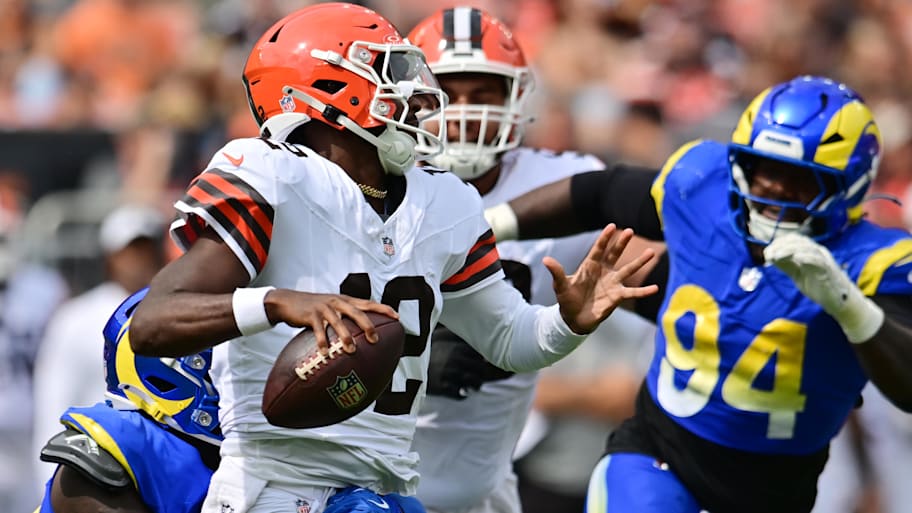
Browns
Coverage of the Browns quarterback situation is out of hand. And I don’t think the way people are rallying behind him is constructive for Shedeur Sanders.
Let’s lay out the facts. The Browns gave Kenny Pickett, Dillon Gabriel and Sanders a ton of reps in the spring, with each getting the chance to prove themselves worthy of reps in the summer, when Joe Flacco would compete with whoever was up for the job. Sanders was significantly behind Gabriel. Gabriel, while limited in some ways, showed good football know-how (no surprise, he was in college for six years and started more games than anyone in college football history), and instincts, and that he could operate the offense.
So when they got to the summer, reps were set up mainly for Pickett to compete with Flacco, with some first-team opportunities for Gabriel sprinkled in, and Sanders mostly in a developmental spot. Injuries hit, and Sanders got to start the game against Carolina, then got hurt. Gabriel started against Philly. Both then played after Flacco against the Rams.
What we saw in both was what the scouting reports showed on each coming out of college. Gabriel could efficiently run an offense and was polished in his field vision and pocket movement. Sanders sees the field slower, and has a bad habit of drifting and bailing out of the back of the pocket, but is tough and accurate, and has proven himself a winner—even if he would need time to develop into a pro quarterback.
What we saw in Gabriel against L.A. was pretty consistent with that. Sanders, too.
Meanwhile, there was a lot of noise over the past few days on what “really” happened in Cleveland with Sanders. At one point, there was a conspiracy theory floating around that the NFL conspired to make sure he fell in the draft, then forced the Browns to take him in the fifth round, and since then, the Browns have conspired to make him look bad to justify the selection of Gabriel in the third round. Remember, this is a Browns team that needs affordable options at quarterback because of the Deshaun Watson contract.
I saw a couple of people saying that the linemen looked “different” with Sanders in, as if Kevin Stefanski is tapping a guy whose career is on the line in the third and fourth quarter of a preseason game and telling him to stop blocking to satisfy some weird personal agenda. That guy being one who Stefanski, GM Andrew Berry & Co. have to evaluate, by the way.
None of it makes any sense, and it 100% illustrates why some teams might have shied away from Sanders on Day 3 of the draft. Here’s the thing: If a team needing a quarterback thought Sanders was a franchise quarterback, they would have taken him in the first round. If one that doesn’t need a quarterback thinks that, they’d have taken him on Day 2 and stashed him. But if you think Sanders is a developmental prospect with limited upside (which is how a lot of folks saw him), then, logically, would you want all the noise the Browns are getting now?
I couldn’t tell you what Will Howard did the past three weeks in the Steelers’ preseason games, and I love Howard for what he did for my alma mater last year. I saw a few throws Riley Leonard made for the Colts on social media the past couple of weeks. I know Kyle McCord’s probably losing his spot in Philly, based on the trade for Sam Howell on Sunday. As far as Graham Mertz, Cam Miller, Kurtis Rourke and Quinn Ewers, crickets.
That’s a good thing for those guys. Some Day 3 quarterbacks make their teams. Others land on other teams, or practice squads. They get a chance to develop and they either make it or they don’t. That’s what Sanders needs now: a chance to develop in the shadows.
Unfortunately, he’s not getting it because some people won’t let go of the perception that he was a first-round prospect, when the NFL didn’t see him that way.
It’s O.K. to concede that, by the way. There are plenty of excellent college QBs who have been in this spot.
So, the time has come for everyone to let him be there. If he develops into more than what he is right now, that would be tremendous for the Browns, and they know it. That said, the public’s inability to accept this for what it is, and has been since well before the draft, isn’t helping Sanders.
It’s part of why he was still there at pick No. 144. And it’s not doing anyone any good now (except for maybe internet aggregators and talk-show producers).
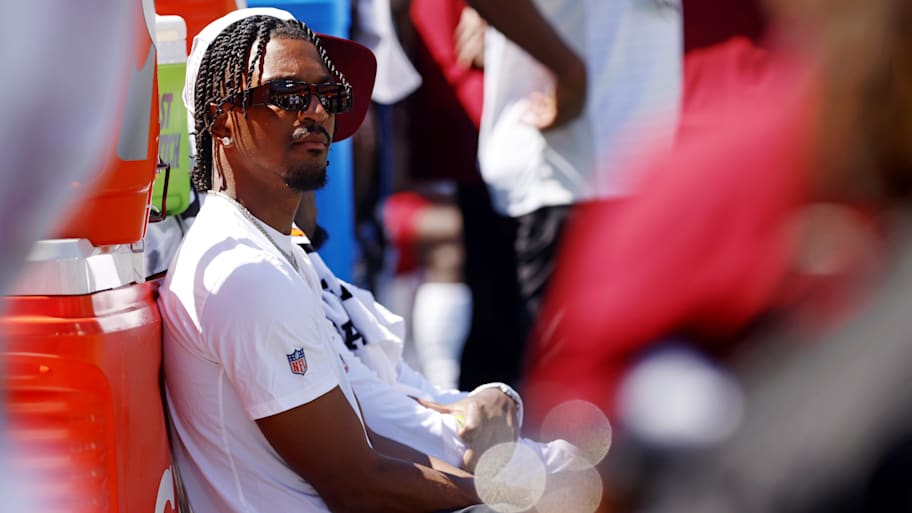
Jayden Daniels
Jayden Daniels’s steps in his second year have been subtle, have happened quietly, and should set the Commanders up to follow up on his historic rookie year. When I got to D.C. last week, and to Dan Quinn’s office in the team’s Virginia headquarters, the one thing I wanted to ask was where we, as NFL viewers, will see a difference in Daniels’s game.
He gave me something that you might not be able to see, unless you’re paying very close attention to what’s happening between the white lines.
“What I’ve noticed already is he’s now making others better by his ability to communicate, postsnap,” Quinn says. “I noticed early on in practice, it was very early on. [Second-year TE] Ben Sinnott was running a corner route, and the ball came kind of early to Ben. Before, I don’t know if he would’ve articulated this—so he came up after the play, and said, Look for it earlier. I’m not going to throw it near the corner, so it’s gonna be on your back shoulder. And it made Ben totally see that play differently. Now, he wasn’t just running a route. It was, I have to look and if the corner’s there, it’s gonna come quickly.
“Last year, I think he would’ve waited for the coaches to maybe explain that. So that’s an example of how he’s helping others grow.”
It’s also a good example of how advanced he already was coming out of college.
Some of that, of course, was obvious in how comfortable Daniels looked—uncommonly so—for a quarterback playing through his rookie year. When it was over, he’d completed 69% of his throws for 3,568 yards, 25 touchdowns, nine picks and a 100.1 passer rating, while rushing for 891 yards and another six touchdowns. That was while guiding the Commanders to 12 wins, and before he piloted road playoff wins in Tampa and Detroit.
Obviously, all of that adds up to a quarterback who was ready, and the fact that Daniels was a multi-year starter in both the Pac-12 and SEC, with a total of 55 college starts on his résumé, is what got him there.
What was tougher to see was how advanced Daniels was as a quarterback.
“He was on it pretty good,” Quinn continued. “By the middle of the year, he was changing the protections, doing the things at the line of scrimmage with us being no-huddle. He’s good at identifying, and he can process quickly.”
Quinn then stopped and added, “But now, helping others get better, I think that’s a big deal.”
It didn’t happen as much last year for a variety of reasons. One was, yes, that he was learning as he went. Another was that he was a rookie and knew his place. A year later, the dynamic has shifted, and Daniels is leaning into that.
“It’s the smallest cues—to say, it’ll be here, or to this leverage,” Quinn continued. “This year, a rookie had jumped offside and he just quietly went over and said, ‘Get out.’ He didn’t make a big deal of it. But it was his way of saying, It’s not good enough. It wasn’t a scene. It was, get out. He’s always had high standards, but when you ask me what’s different, I’d say he is now multiplying others.
“Having Marcus [Mariota] helps; they’ve got a rare connection at quarterback. They talk; they communicate a lot. Maybe that pushed him into that space, maybe he just got there with his knowledge of the offense. But that’s been impressive, how he’s pushing others.”
It’s exciting, too, and could be needed in the short term, depending on how things play out with Terry McLaurin, with guys such as rookie Jaylin Lane potentially pushed into bigger roles.
In the long term? It’s pretty much exactly what you’re looking for from your quarterback.
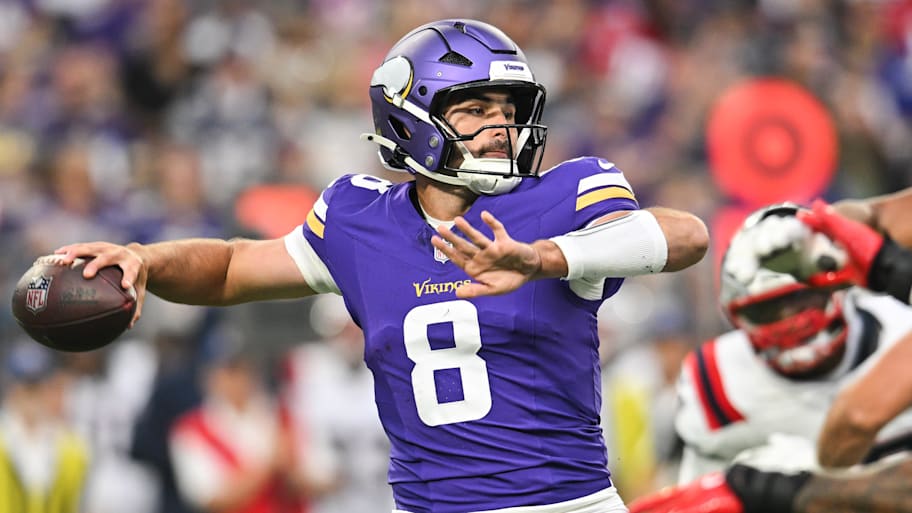
Sam Howell trade
Speaking of the Sam Howell trade, I like it for both sides. And I can explain why, and show you why I’m addressing what otherwise would look like a run-of-the-mill, pre-cutdown move involving a backup.
• On the Eagles’ end, it shows the relentless churning the organization does at the most important position on the field. People in that building have grown tired by the phrase “quarterback factory,” but that is the idea here.
Let’s start with Howell himself. His situation isn’t unlike Kenny Pickett’s a few years ago. He’s started a bunch. He may not have fit perfectly where he was at, and he’d be available for a relatively minimal return. In the case of Pickett, they got him for a third-rounder and two seventh-round picks. They got a year of service from him and flipped him to Cleveland for a fifth-round pick and another quarterback (Dorian Thompson-Robinson).
So, they essentially moved one pick down two rounds, and then gave up two picks that were lower in the order than the 10 picks they wound up making in the first six rounds (and, because of the depth of Philly’s roster, there’s a good chance those seventh-rounders don’t make the team), while getting a year of service from Pickett and a look at another QB.
In the case of Howell, they moved a pick down from the fifth round to the sixth round in this year’s draft and gave up a seventh-rounder in 2027. In the short term, he gives them another layer of insurance with backup Tanner McKee nicked up. In the longer term, he gives them flexibility to deal McKee, whom they love and who has drawn outside interest, if someone gets in a desperate spot and wants to make the Eagles a crazy offer for him.
There’s a humility to all this, too, for what it’s worth. It’s basically the Eagles saying it’s hard to hit on quarterbacks at all levels of the depth chart, so they’re going to give themselves as many shots as possible at finding more (with McCord’s selection a part of that strategy).
• On the Vikings’ side, the availability of Carson Wentz, who just played in a version of Kevin O’Connell’s offense with the Rams, brought some flexibility.
To acquire Howell from Seattle in April, all the Vikings had to do was move a pick down 30 slots in the fifth round. They got a four-month look at him, and now are flipping him for what’ll likely be a bigger jump in a 2026 pick, plus an extra pick in 2027.
That, to me, is good asset management, and if the Vikings wind up better off with Wentz as insurance for J.J. McCarthy than they were with Howell, they’ll be no worse for the wear.
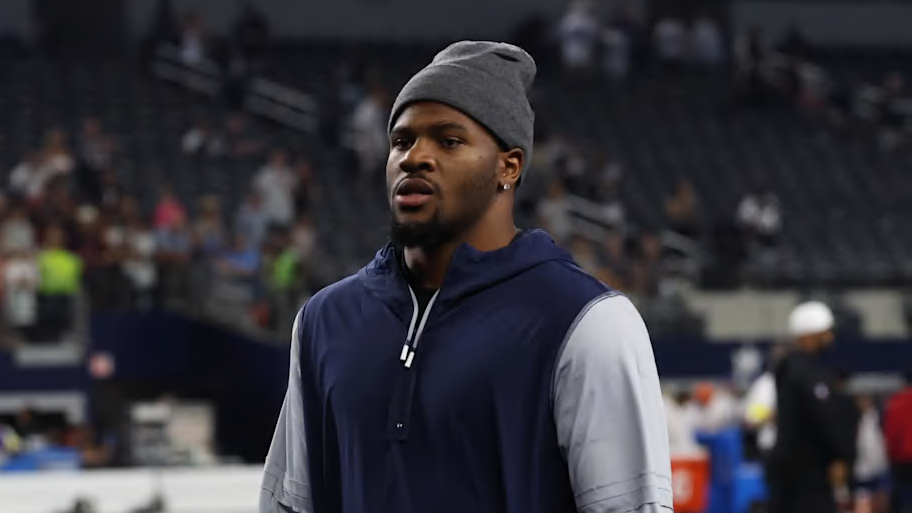
Micah Parsons negotiations
We should address what everyone saw over the weekend between Micah Parsons and the Cowboys. In case you didn’t see it, a couple of clips went viral, one of Parsons coming into the stadium munching on a container full of nachos, another where he was seen lying on a trainer’s table (he wasn’t lying there the whole night). He was also, allegedly, the only player on the sideline not wearing a jersey during the game against the Falcons.
Parsons is smart. He knows what he’s doing, and understands the optics of it and, based on his contract dispute with the team, how his actions would be perceived.
Meanwhile, you have the owner going on with Stephen A. Smith and, again, seemingly only inflaming the situation further. At one point, Jerry Jones said to Smith, “We got him for three years, no matter what,” to bring to life the leverage the Cowboys have over Parsons, with the ability to franchise him in 2026 and ’27, added to the year left on his rookie contract.
Then, Jones dipped into his seemingly endless reservoir of home-spun analogies.
“How many times have you seen the little rascal, so clever, go in there and momma told him, Uh-uh, you’re not gonna get it, and goes into daddy, who only sees him after 5 in the afternoon, wants to love him, and says, You can have it, son. You can have it before dinner,” Jones told Smith. And he goes back in and says, Momma, Daddy said I can have it. Mom and Dad been around since the beginning of time. I’m not gonna go for that s--t here.”
Jones then repeated that he and Parsons had a strong negotiation and asked, “Guess who has to be comfortable for this to work?” Smith answered Parsons and Jones, and then Jones said, “And who else? Hello, there’s no room for a third.” The insinuation being, again, that Parsons’s mega agent, David Mulugheta, has been the stick in the mud of the talks.
So if you’re keeping score at home, Jones basically accused Mulugheta of running an end-around, and said he’s irrelevant to the negotiation, after Parsons has publicly said he’d stand behind him. Parsons seemed to show his displeasure for all this on the game field in front of all the cameras (which, honestly, Jones actually may not have hated).
Then, there’s the backdrop of previous Dallas negotiations. The pacing and timeline of this one, at least until this point in the calendar, isn’t unlike what happened last year with Dak Prescott and CeeDee Lamb, and isn’t totally dissimilar to the Zack Martin dispute the summer before that. In all three, some negotiation happened earlier in the offseason, and then there was radio silence, before a mad rush to get a deal done before the opener.
Is this one different? In a couple of ways, yes. Those who know Parsons well would tell you he’s dug in and could miss games to prove a point. Conversely, Prescott, Lamb and Martin were all wildly popular figures in the locker room, and within the organization as a whole, and it’s not quite the same with Parsons.
And then, there’s the backdrop of Jones being one of the hardline owners with his peers on setting contractual precedents and maintaining control over the workforce.
I still have a hard time seeing Jones not getting something done with a guy who’s his best player and one of his brightest stars before the start of the season. But this one’s only gotten more passive-aggressive and more personal, so we’ll see what happens.
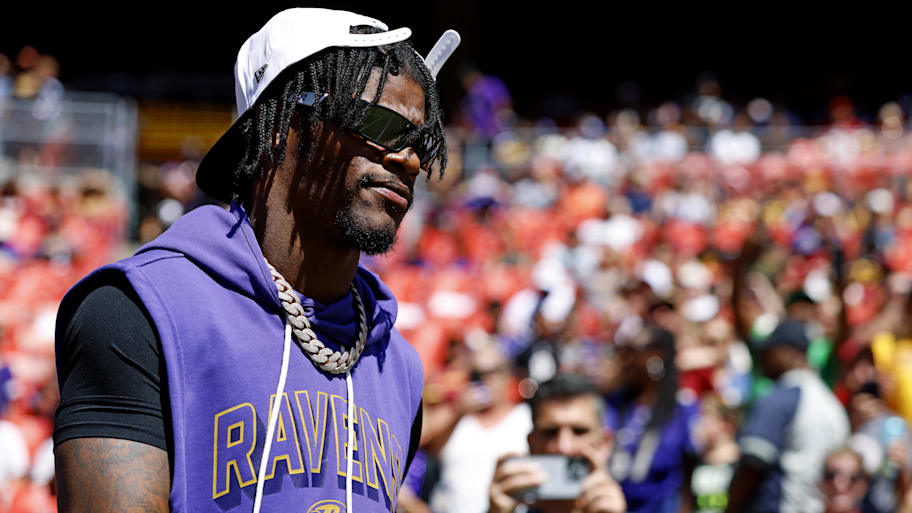
Ravens
I think the Ravens aren’t being talked about enough. Maybe it’s because I was just there last week. But before then, I’d heard these whispers from coaches and personnel guys with other teams—the Ravens think they’re going to be really good. And after getting around them, I have no reason to tamp down any of that. There wasn’t a lot of brake-tapping going on when I asked people there about it, and that’s for good reason(s).
Here are a few.
• The Ravens have the second-best record in football since drafting Lamar Jackson in 2018. They’re 78–38, short of only the Chiefs in that time frame, through which they’ve been a playoff team in six of seven seasons, won four division titles, and carried the No. 1 seed in the AFC into the playoffs twice. No, they haven’t made it to a Super Bowl with this group, but they’re battle-tested, and generally if you’re knocking on the door this much …
• Last year, there was a big offensive line question with three new starters. Now, that unit is young, promising and improving, and a perfect example of the player-development machine that’s been churning for a quarter century now in Baltimore. Because of it, there’s no discernible weakness on the roster, and there’s plenty of depth in most areas, with the next crew of young stars (Tyler Linderbaum, Zay Flowers, Travis Jones, Mike Green, Malaki Starks, Nate Wiggins, etc.) in place under that established, war-worn core.
• There are a couple of areas of overwhelming strength. One is the Jackson–Derrick Henry backfield. Another is a secondary that’ll start five former first-round picks, and has All-Pro talent like Kyle Hamilton headlining the group. Four of the five guys back there are homegrown, with Jaire Alexander joining from Green Bay.
• Much like the offensive line had questions early in the year, the coaching staff did, too, with Mike Macdonald’s departure for Seattle. But, in time, the installation of Zack Orr as DC looked an awful lot like Macdonald’s—a little rough in the beginning with a ton of growth through it that produced, by the end of the year, one of the best defenses in football. And on the other side of the ball, OC Todd Monken’s back for his third year in town.
• Then, there’s Jackson himself, who’s now won two MVPs and played well enough to win a third last year (it went to a richly deserving Josh Allen, but both guys were worthy of it). Those in-house in Baltimore say he’s made a leap this offseason in the dropback passing game, which rounds out his vast skill set and should make him and the Ravens offense even more lethal in his eighth NFL season.
Add all that up, and that the Ravens were a Mark Andrews two-point drop away from overtime against Buffalo in the divisional last year—with the Bills having taken Kansas City to the wire in the title game the following week—and I’d say this is a team worth watching, in case you’d forgotten about them.
And also an operation that keeps functioning at a ridiculous level.
Titans
This will be a very active week for the Titans. As I’m sure you know, Tennessee had the first pick in the draft, using it on Cam Ward, which means they get the first selection in the waiver order from now through Week 3. And I’d expect that they’ll be very active, with the reshaped front office spending a ton of time the past few weeks combing through preseason tape to check out the bottom half of the other 31 teams’ rosters.
“The benefit of being No. 1 in the waiver claim is that you have first crack at anybody you think upgrades your roster,” coach Brian Callahan told reporters Saturday. “I know [G.M.] Mike [Borgonzi] and his crew have been hard at work. They’ve watched every player in the preseason, watched every preseason game of every team, and they have a really good feel for what’s out there. You never know what is going to shake free, or not shake free, so you do your due diligence and you are ready for it when it comes.
“There are going to be opportunities to claim some players that will help us.”
Here are the facts: The Titans’ roster needs a lot of work. There are big questions at a lot of spots, and there aren’t 53 guys on the team that would make most teams. So they’ll look hard at swapping out guys, maybe more so at places like corner than other spots. I’d expect that to continue into the regular season, as they try to upgrade everywhere.
The cutdown, for those who don’t know, is at 4 p.m. Eastern Tuesday. Waiver claims are then put in, and those claimed are awarded to teams at noon on Wednesday, after which teams can start signing guys to their practice squads.
There won’t be a million of them—remember that contracts are part of this, and picking up one guy means having to get rid of another who you’ve been working with—but the ones that do happen can often be illuminating on where teams see themselves. If a team is making four or five claims, then it says something about where their roster is. If a team has a bunch of its guys claimed, then it reflects well on the depth it brought to camps (having a lot of guys claimed can be a point of pride for personnel departments).
It’s a pretty wild day or two, for sure. I’m just thankful it’s not on Labor Day weekend anymore (which means I can go to Columbus).
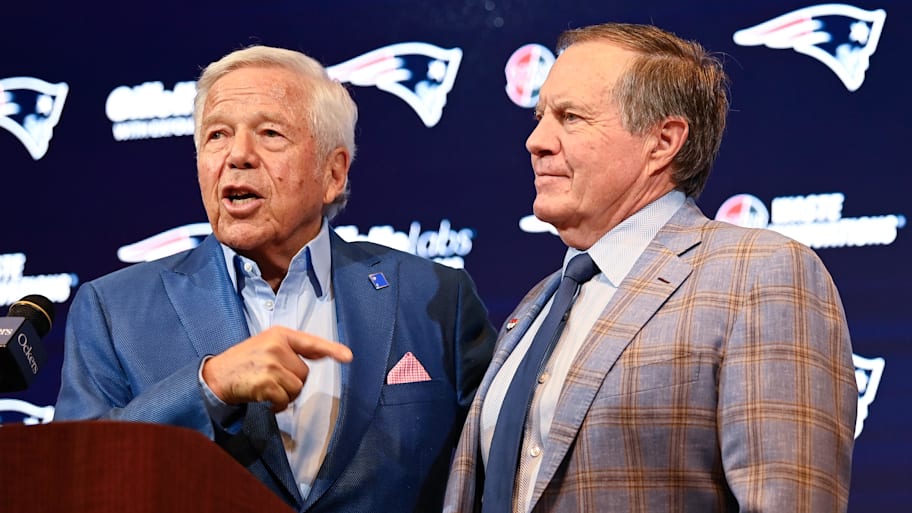
Bill Belichick/Kraft family
Bill Belichick and the Krafts, at some point, should sit down and work things out. To me, this has reached Jimmy Johnson–Jerry Jones levels, with Belichick’s comments to the Boston Globe’s Ben Volin last week—saying a benefit of being at the college level is that “there’s no owner, there’s no owner’s son”—a very, very clear shot at Robert and Jonathan Kraft.
It was also, by the way, a shot at a league that shunned Belichick through the 2024 coaching carousel, then was lukewarm on him ahead of the ’25 carousel when his camp put feelers out before he accepted the University of North Carolina job.
But on the Kraft–Belichick dynamic, the obvious problem here is how credit is assigned for the unprecedented two-decade run the Patriots had together. Belichick saw the Kraft-fueled Apple TV series, The Dynasty, as an effort to ensure Kraft got more than the coach, particularly after players said positive things they’d said about Belichick weren’t included in the final edit. And since he’s been sensitive toward a lot of comments Robert Kraft has made about the two-decade run (Kraft’s Hall of Fame candidacy is a factor in all this, too).
So how does this thing end?
I don’t know. However, what I do know is these guys are a lot older than Jerry and Jimmy were at the time of their split, meaning that (not to get dark here) they have less time to figure it out than the architects of the Dallas dynasty did.
And it’d be a shame if this doesn’t get fixed in their lifetime.
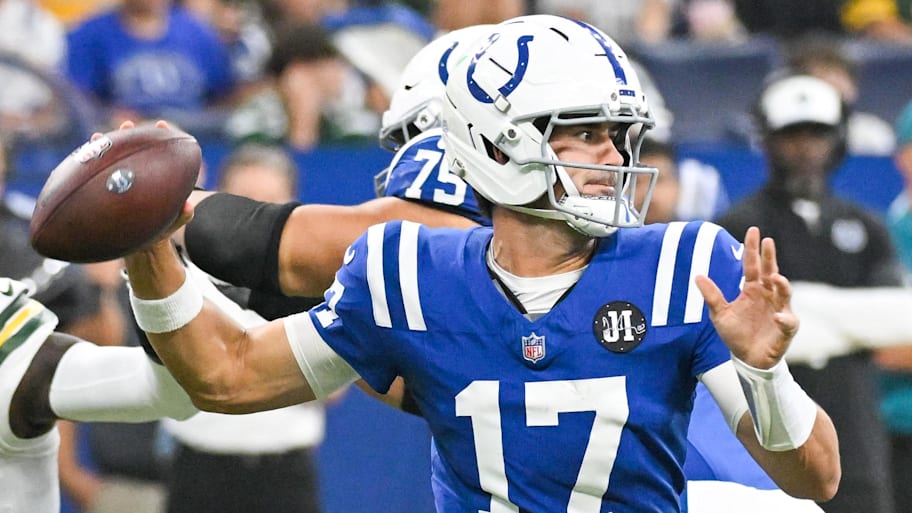
Quick-hitters
We’re 10 days away, and we have your quick-hitters coming now. In wrapping up this week’s Takeaways …
• Seeing Pete Carroll say, “We’re looking everywhere” for a replacement for backup QB Aidan O’Connell on the depth chart reminded me of how relentless he and Schneider were in churning the Seahawks roster in their first year in Seattle (2010). Maybe it’s a precursor to how Carroll and John Spytek handle the next few months in Vegas.
• Mike Vrabel’s comment about “rats” in the Patriots’ organization got my attention. I think it’s indicative of a new regime that knows it has a ways to go in cleaning up what was inherited, and maybe that people are getting a little ahead of themselves in expectations for the team in general.
• I think Aidan Hutchinson’s about to have a massive year. Mark me down for 15 sacks for the Lions’ star rusher and a massive contract, too, whether it’s now or after the season.
• Jets QB Justin Fields has been the right kind of person for the organization at the position in just about every way. Now, how good will he be between the lines? We’ll see. But I’d say there’s a lot that new OC Tanner Engstrand can do with him that New York hasn’t put on tape—intentionally—yet. So I’ll reserve judgment after some preseason ugliness.
• Right tackle Taylor Moton’s extension in Carolina flew under the radar, and I get why. Still, it’s a good indication of the franchise finally getting some stability in that position group. It was a problem there going back to the Ron Rivera era, to the point where having all five starters they like back for a second consecutive year is a significant organizational win.
• I have no idea what the Saints are going to do at quarterback. But it seems like a good bet that both Spencer Rattler and Tyler Shough will draw starts this fall (and who knows how much further it goes from there?).
• It’s good to hear Najee Harris is healthy and trending toward playing in September. But it looks like his absence left the door open for Omarion Hampton to make the Chargers’ tailback job his own, and my sense is Hampton’s done just that.
• The Colts’ decision to go with Daniel Jones was simple, in the end. Anthony Richardson hasn’t come along fast enough, and the coaches couldn’t give the other 10 guys in the huddle the same answer they have had the past two years. In Jones, the feeling is that Indianapolis at least has a guy who can go out there and operate the offense efficiently, and give Jonathan Taylor, Michael Pittman Jr., Tyler Warren and others a shot to make plays.
• The Trey Hendrickson negotiation should come to a head soon. The Bengals have pumped the APY (average per year) way up to try to sidestep breaking their precedents on guarantees. Hendrickson is focused on winning the battle over the guarantees—and landing in the Ja’Marr Chase category rather than the Tee Higgins category. So we have a good old-fashioned standoff. We’ll see if deadlines help force a deal.
• And on that topic, I do feel like the Commanders and McLaurin will find a middle ground before the season. The problem, as I’ve heard it, is that the gap at the beginning of negotiations was massive. It’s narrowed since. I think both sides are motivated to get something done. It makes too much sense for everyone involved and, again, maybe a deadline is what’s needed.
This article was originally published on www.si.com as NFL Takeaways: Why the Niners’ Super Bowl Window Could Reopen.
